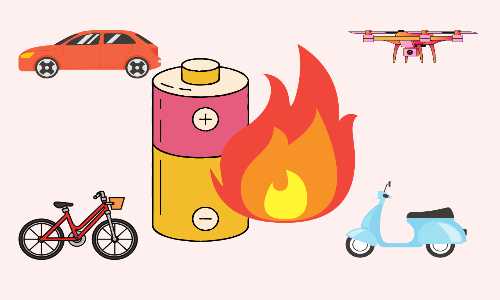Why do electric vehicles catch fire?
Electric vehicles (EVs) are becoming increasingly popular across the world. While the risks associated with conventional vehicles are well-defined and generally accepted by society, time and education are needed to achieve this comfort level for Li-ion battery-powered vehicles.If Li-ion batteries are damaged there is a significant risk of electric vehicles catching fire. Even after the fire is extinguished, there are chances of re-ignition[1]. Apart from firefighters, these factors have to be taken into account by those handling damaged EVs for example during towing, scrapyard or workshop. Currently, Li-ion batteries are the preferred choice for electric vehicles. Their unrivalled characteristics, such as long cycle life, high energy density, and improved efficiency, make them ideal for automotive applications.
Fire Risks associated with Li-ion Batteries:
As more Li-ion battery-powered vehicles become operational across the world, their involvement in mishaps is anticipated to climb. As with conventionally powered vehicles, the energy stored on board has the potential to pose a threat to the safety of individuals involved in an accident. The safety concerns with Li-ion batteries have gained attention as a result of videos and press stories showing fire and smoke coming out of phones, computers, and hoverboards while being used or during charge.
Battery Fire Causes:
Battery fires can have far-reaching repercussions, including harm to other system components and/or human injury or death. It can land OEMs in a legal soup, employees can get demoralized after an accident, customers and investors start questioning the quality of engineering and overall the brand takes a major hit. Worse, the entire EV movement will get delayed. Bad cell design or manufacturing flaws, external abuse (thermal, mechanical, electrical), poor battery assembly design or manufacturing, inferior battery electronics design or manufacturing, or substandard support equipment (i.e. battery charging/discharging equipment) design or manufacturing, are all possible causes of battery failure.
- Internal Short Circuit: This cataclysmic event might happen without notice. Manufacturing flaws or physical damage from dendrite growth or mechanical deformation might cause this [2]. When an internal short circuit develops, the harm that results is severe. The short circuit causes the cell to release all its energy. Since high electric current travels through a conducting substance it leads to a lot of heat generation. Rapid heating in this location can lead to thermal runaway.
- Mechanical Deformity: Crash or ground impact scenarios can cause severe deformation. Damage to the high voltage system might result in short circuits and arcing, as well as the release of combustible substances. A variety of factors determines the severity of an internal short circuit caused by accidental circumstances. It entails the interplay of mechanical contact, heat production, and electrical discharge, which can lead to thermal runaway. Battery packs are often installed in automobiles’ rigid and reinforced sections. It should be noted, however, that these packs are still vulnerable to penetration in case of accidents, minor overlap incidents, and road debris impacts. The forces generated by a vehicle’s quick deceleration in an accident may be strong enough to cause an external short circuit, causing further damage.
- Charge: Lithium-ion batteries can accept and store a specified quantity of energy over a set period of time. When these limitations are surpassed, either by charging too rapidly or overcharging, the cell’s performance might deteriorate or even fail. The state of charge (SOC) is commonly used to describe the charge level of batteries: The SOC ranges from 0-100 per cent, with 100 per cent SOC indicating that the battery is completely charged to its rated capacity. Overcharging can occur when the charging control system improperly detects the State of Charge or when the charger fails, or when an inappropriate charger is used. Overcharging can cause the anode material to become lithiated [3], in which lithium-ion intercalation stops and lithium metal forms on the anode as a consequence. These deposits can develop into dendrites, which are metallic fingers. They can eventually breach the separator and produce an internal short circuit as they proliferate. At the cathode, the opposite occurs. Overcharging may cause the cathode to become de-lithiated to the point that it thermally decomposes and generates heat.
- Discharge: Li-ion travels from the negative current collector (anode) to the positive current collector (cathode) when lithium-ion batteries are discharged. The anode which is made up of copper might disintegrate if the discharge level becomes too deep. As a result, small conductive copper particles are discharged into the electrolyte, raising the possibility of an internal short circuit. It can also result in the evolution of hydrogen and oxygen, as well as cell venting and cathode plating. When battery cells are discharged below their minimum voltage, it is known as over discharge abuse.
- Exposure to higher temperatures: Thermal stability is one of the limiting aspects of Li-ion batteries in terms of safety. Exothermic reactions and internal degradation processes might occur when exposed to higher temperatures. When the battery reaches thermal runaway stage, breakdown mechanisms kick in, causing the battery to produce more heat.
The safety solution for battery packs will be discussed in the next article. Stay tuned!

